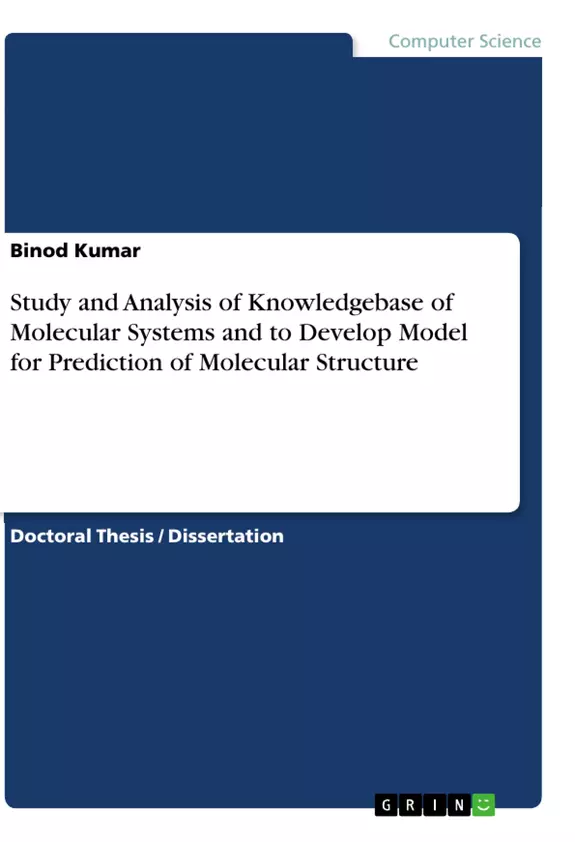This research work aims to analyze experimental data about biochemical properties and their corresponding kinetics. In this research the attempt has been made to analyze protein and DNA structure using tools such as DAMBE and Jemboss. Some Molecular Visualization or Analysis tools are already developed that reads, analyses, and crosscorrelates experimental information which is useful for chemist, Organist Chemist, Biochemist and Druggist. In this research using ACD/ChemSketch compounds are stored in databases and SMILE code (Simplified Molecular Input Line Specification) is generated. A SMILE defines the molecules in the form of alphanumeric chains. In this research work chemical shift of every carbon atom of the molecule have been displayed by using NMR Prediction. Under this research CML codes of molecules have been developed and that codes have been used for molecular information like symmetry, and atom and bond attributes. Here multiple observations of the same molecule like conformational analysis and NMR prediction have been performed. Using Pubchem/NCBI additional miscellaneous information such as bioactivity analysis by structure & activity similarity and revised compound selection after addition of similar compounds have been analyzed. Under the research work geometric optimization of molecules, chemical structure visualization and calculation of electronic absorption spectra of chemical structure have been performed using ArgusLab tool. In this research Single Entry Point Calculation, Molecular Orbital calculation on grids for plotting HOMO and LUMO and ESP Mapped Density calculations have been also performed. Under the research work of different types of analysis like prediction of protein secondary structure, isoelectric point calculation etc. have been performed on nucleotide and protein sequence using DAMBE and Jemboss tools. The objective of this research work is to assist the organic and biochemist in each step of the synthesis planning process for prediction of molecular structure. This research work provides a series of methods and tools for chemical or biochemical applications. Built-in catalogs of fine chemicals or biochemical provide suitable starting materials for a synthesis or molecular structure prediction target. Using similarity searches or substructure searches the connection between the target compound and available starting materials has been achieved.
Inhaltsverzeichnis (Table of Contents)
- I Introduction
- 1.1 Introduction
- 1.2 The Research Area, Problem Domain and Literature Survey
- 1.3 Relevance of research
- 1.4 Details of Remaining Chapters
- 1.5 References
- II Computational Techniques, Tools and Technologies to support
Bioinformatics
- 2.1 Introduction
- 2.2 ACD/ChemSketch
- 2.2.1 Introduction
- 2.2.2 ACD/ChemSketch includes
Zielsetzung und Themenschwerpunkte (Objectives and Key Themes)
This doctoral thesis aims to investigate the knowledgebase of molecular systems and develop a model for predicting molecular structure. The research focuses on utilizing computational techniques, tools, and technologies within the field of bioinformatics to address this challenge.
- Analysis of existing knowledgebase in molecular systems
- Development of a model for predicting molecular structure
- Evaluation of the model's effectiveness and accuracy
- Application of computational techniques in bioinformatics
- Contribution to the advancement of molecular structure prediction
Zusammenfassung der Kapitel (Chapter Summaries)
The first chapter introduces the research topic, providing context and outlining the research area, problem domain, and literature survey. It highlights the relevance of the research and details the structure of the remaining chapters. Chapter two explores computational techniques, tools, and technologies that support bioinformatics, with a particular focus on ACD/ChemSketch, a software package used in molecular modeling.
Schlüsselwörter (Keywords)
This research delves into the key areas of molecular systems, molecular structure prediction, bioinformatics, computational techniques, and software tools like ACD/ChemSketch. The study explores the knowledgebase of molecular systems, the development of a predictive model, and the application of these tools in the field of bioinformatics.
- Quote paper
- Dr. Binod Kumar (Author), 2010, Study and Analysis of Knowledgebase of Molecular Systems and to Develop Model for Prediction of Molecular Structure, Munich, GRIN Verlag, https://www.grin.com/document/509300



